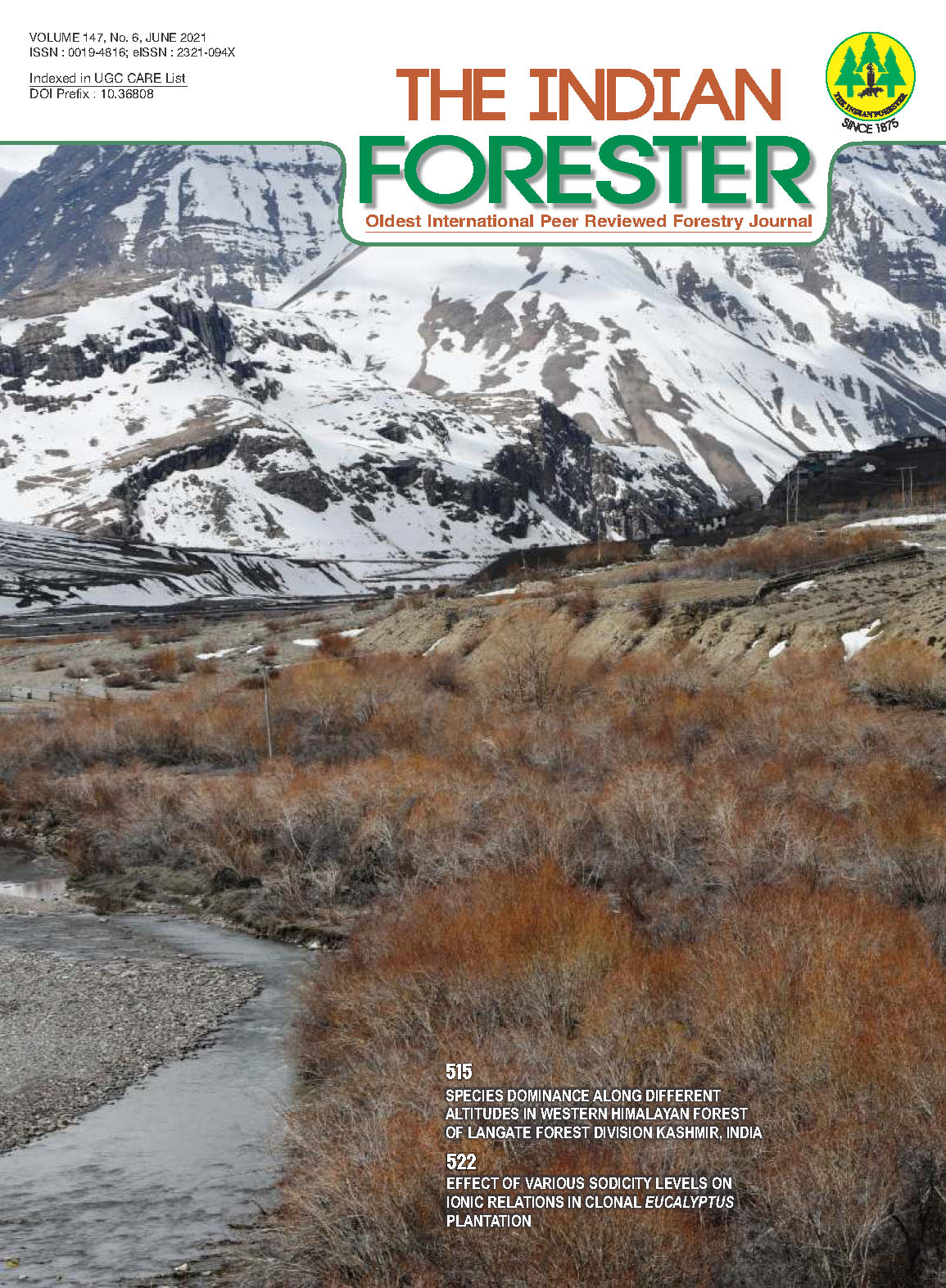Documentation of Vascular Plants of Mudumalai Tiger Reserve, Western Ghats, India
DOI:
https://doi.org/10.36808/if/2021/v147i6/153595Keywords:
Biodiversity, Reserve Forests, Mudumalai Tiger Reserve, Sanctuary, Western Ghats.Abstract
The wide range of climatic factors and their interaction reflect the diversity of the vegetation communities. The major vegetation types of Mudumalai Tiger Reserve (MTR) includes Southern Tropical dry thorn forest, Southern Tropical dry deciduous forest, Southern Tropical moist deciduous forest, Southern Tropical semi-evergreen, moist bamboo brakes and Riparian fringing forest. A total of 426 plant species under 311 genera belong to 100 families, including infraspecific taxa were recorded from the study area. Fabaceae is the dominant family with represents 42 species; similarly Ficus is the dominant genera with 9 species have been recorded. The MTR is a home for many rare and threatened plants. The present study we recorded 81 plants are under threatened condition. Using vegetation data collected from the larger Nilgiri Biosphere Reserve, in and around the five tribal settlements in Mudumalai Tiger Reserve. The current study concluded that the MTR poses a severe and persistent conservation threat to both within and outside protected reserve forests.References
Appolinario V., Filho A.T.O. and Guilherme F.A.G. (2005). Tree population and community dynamics in a Brazilian tropical semi-deciduous forest. Revista Brasil, 28(2): 347-360.
Chittibabu C.V. and Parthasarathy N. (2000). Attenuated tree species diversity in human-impacted tropical evergreen forest sites at Kolli hills, Eastern Ghats, India. Biodiversity and Conservation, 9: 1493-1519.
Dharmendrakumar N.V. (2015). Floristic and ecological studies of Thol Lake Wildlife Sanctuary North Gujarat. Ph.D. Thesis, Hemchandracharya North Gujarat University, Gujarat.
Dudley N. (2008). Guidelines for Applying Protected Area Management Categories. IUCN, Gland, Switzerland.
Dudley N., Stolton S., Belokurov A., Krueger L., Lopoukhine N., MacKinnon K., Sandwith T. and Sekhran N. (2010). Natural Solutions: Protected areas helping people to cope with climate change. IUCN, Gland, Switzerland and Washington DC.
Gamble J.S. and Fischer C.E.C. (1915-1936). Flora of the Presidency of Madras. Vols. 1-3. Adlard & Sons Ltd., London.
Gentry A.H. (1988). Tree species richness of upper Amazonian forests. Proceedings of the National Academy of Science of USA, 85: 156-159.
Henry A.N., Kumari G.R. and Chithra V. (1987). Flora of Tamil Nadu. Series 1.Vol. 2. Botanical Survey of India, Coimbatore.
Henry A.N., Balakrishnan N.P. and Chithra V. (1989). Flora of Tamil Nadu. Series 1.Vol. 3. Botanical Survey of India, Coimbatore.
Hooker J.D. (1872-1897). The Flora of British India. Vols. 1-7. L. Reeve & Co., London.
IUCN. (2002). IUCN Technical Guidelines on the Management of Ex-situ Populations for Conservation. 14th Meeting of the Programme Committee of Council, Gland Switzerland.
Krishnamurthy Y.L., Prakasha H.M. and Nanda A. (2009). Floristic Diversity of Bhadra Wildlife Sanctuary in the Central Western Ghats Region, Karnataka. Indian Forester, 135(10): 1397-1406.
Linder P., Elfving B. and Zackrisson O. (1997). Stand structure and successional trends in virgin boreal forest reserves in Sweden. Forest Ecology and Management, 98: 17-33.
Matthew K.M. (1983). Flora of the Tamil Nadu Carnatic. Vols 1-3, Rapinat Herbarium, Tiruchirappalli.
Nair N.C. and Henry A.N. (1983). Flora of Tamil Nadu. Ser.1. Vol. 1. Botanical Survey of India, Coimbatore.
Padalia H., Chauhan N., Porwal M.C. and Roy P.S. (2004). Phytosociological observations on tree species diversity of Andaman Islands, India. Current Science, 87: 799-806.
Pettit N.E., Naiman R.J., Fry J.M., Roberts D.J., Close P.G., Pusey B.J., Woodall G., MacGregor C.J., Speldewinde P., Stewart B., Dobbs R., Paterson H., Cook P., Toussaint S., Comer S. and Davies P.M. (2015). Environmental change: prospects for conservation and agriculture in a southwest Australia biodiversity hotspot. Ecology and Society, 20(3): 10.
Prabakaran R. and Greeshma V. (2012). Floristic analysis and Phytosociological studies on trees of Perumal Malai hill, Salem, Tamil Nadu. International Journal of Research in Pharmaceutical Sciences, 3(2): 192-194.
Raja P., Soosairaj S., Dhatchanamoorthy N. and Tagore J.K. (2015). Floristic composition of aquatic angiosperms in different wetlands of Pudukkottai district of Tamil Nadu, India. Asian Journal of Plant Science and Research, 5(12): 6-12.
Reddy S. and Pattnaik C. (2009). An assessment of floristic diversity of Gandharmardan hill range, Orissa, India. Bangaladesh Journal of Plant Taxonomy, 16(1): 29-36.
Risser P. and Rice E.L. (1971). Diversity in tree species in Oklahoma upland forest. Ecology, 52: 876-880.
Roy D.K., Talukdar A.D., Choudhury M.D. and Sinha B.K. (2014). Diversity in angiosperm flora of Siju wildlife sanctuary, South Garo hills district of Meghalaya, India. Indian Journal of Plant Sciences, 3(3): 87-101.
Roy P., Murthy M., Roy A., Kushwaha S., Singh S., Jha C.S., Behera M.D., Joshi P.K., Jagannathan C., Karnatak H.C., Saran S., Reddy C.S., Kushwaha D., Dutt C.B.S., Porwal M.C., Sudhakar S., Srivastava V.K., Padalia H., Nandy S. and Gupta S. (2013). Forest fragmentation in India. Current Science, 105: 774–780.
Sagar R., Raghubanshi A.S. and Singh J.S. (2003). Tree species composition, dispersion and diversity along a disturbance gradient in a dry tropical forest region of India. Forest Ecology and Management, 186: 61-71.
Sasidharan N. (1999). Floristic diversity of Shendurnuy Wildlife Sanctuary, Southern Western Ghats. Biodiversity, Taxonomy and Conservation of Flowering Plants, Mentor Books, Calicut. pp. 261-273.
Sasidharan N. (2002). Floristic Studies In Parambikulam Wildlife Sanctuary. KFRI Research Report No. 246. Kerala Forest Research Institute, Peechi, Thrissur.
Virupaksha K., Shrihari S., Madhyastha M.N. and Babunarayan K.S. (2009). A new diversity index for evaluation of environmental quality. Journal of Environmental Research and Development, 4(1): 254-257.
Whittaker R. and Niering W.A. (1965). Vegetation of the Santa Catalina Mountains, Arizona: A gradient analysis of the south slope. Ecology, 46: 429-452.
Downloads
Downloads
Additional Files
Published
How to Cite
Issue
Section
License
Unless otherwise stated, copyright or similar rights in all materials presented on the site, including graphical images, are owned by Indian Forester.





